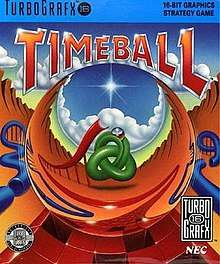Timeball
Timeball is a puzzle video game released by NEC for the TurboGrafx-16. The object of the game is to guide a ball along pieces of track by moving tiles like a sliding puzzle. The game's name in Japan is Blodia, an anagram of Diablo, the title of a computer game upon which Blodia is based. Versions of Blodia were released exclusively in Japan for the original Game Boy and the Sharp X68000. A spin-off titled Blodia Land: Puzzle Quest was released for the Famicom, replacing the ball with cartoon dinosaur-like characters. These versions were developed by Tonkin House and published by Brøderbund.
| Timeball | |
|---|---|
 TurboGrafx-16 cover art | |
| Developer(s) | Tonkin House, Hudson Soft |
| Publisher(s) | TurboGrafx-16: NEC, Hudson Soft Sharp X68000, Game Boy: Brøderbund, Tonkin House |
| Programmer(s) | Manuel Constantinidis (original game) |
| Platform(s) | TurboGrafx-16, Game Boy, Sharp X68000 |
| Release | 1990 |
| Genre(s) | Puzzle |
| Mode(s) | Single-player, Two-player (Game Boy) |
Gameplay

The grid on screen is composed of tiles. Some tiles have a piece of road, and a black tile represents "the void", an area where one can drag the tile nearby in order to complete a road which will be taken by a ball that will follow the path. Players must arrange the tiles such that the ball traverses all sections of track. The ball can be sped up by pressing a button. If the ball reaches a tile without a piece of track, it falls out of play.
The game also includes a level editor which allows for the creation of custom puzzles. An earlier "prototype" version without the level editor was published for the TI-99/4a and other computers as "Diablo" in 1985.